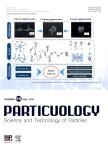Chemical components of PM_(2.5)in different seasons in Harbin,China
作者机构:State Key Laboratory of Urban Water Resource and EnvironmentSchool of EnvironmentHarbin Institute of TechnologyHarbin150090China
出 版 物:《Particuology》 (颗粒学报(英文版))
年 卷 期:2023年第76卷第5期
页 面:113-121页
核心收录:
学科分类:07[理学] 0817[工学-化学工程与技术] 070602[理学-大气物理学与大气环境] 0706[理学-大气科学] 0805[工学-材料科学与工程(可授工学、理学学位)]
基 金:supported by the National Natural Science Foundation of China(grant No.41805097) the Natural Science Foundation of Heilongjiang Province(grant No.YQ2019D004).
主 题:PM_(2.5) Seasonal characteristics Sulfate Nitrate Biomass burning Secondary formation
摘 要:The seasonal characteristics of fine particulate matter(PM_(2.5))were investigated from October 2020 to April 2021(spreading fall,winter and spring)in Harbin,a city located in northeast China.The mass concentrations of PM_(2.5)in winter were significantly higher than those in fall and spring.Moreover,our results indicated that various aerosol species had obvious seasonality.The proportions of secondary components were higher in winter than other two seasons.In contrast,the ratios of nitrate to sulfate(NO_(3)^(-)/SO_(4)^(2-))showed lower levels in winter,which was because both the ratios of nitrogen dioxide to sulfur dioxide(NO_(2)/SO_(2))and the ratios of nitrogen oxidation ratio to sulfur oxidation ratio(NOR/SOR)exhibited lower values in winter than in fall and spring.With PM_(2.5)increased,the NO_(3)^(-)/SO_(4)^(2-)ratios showed increasing trends in all three seasons,which was mainly attributed to the increase of NOR/SOR ratios in fall and spring,and the increase of both NO_(2)/SO_(2)and NOR/SOR ratios in winter.This result highlighted that nitrate was more important than sulfate as a driver for the growth of PM_(2.5)during the period of heavy air pollution.Additionally,the sources of organic aerosol(OA)in different seasons were also distinctly different.Overall,the sum of biomass burning OA(BBOA)and secondary OA(SOA)contributed70%of OA in three seasons.The fractional contributions of BBOA to total OA,notably,exhibited higher levels in fall and spring,because of intensive open agricultural fires.The SOA fractions in OA were larger in winter,likely due to higher relative humidity which facilitated the secondary for-mation.A large increase in the proportions of BBOA was observed during polluted days in fall and spring compared to clean days.In comparison,during heavily-polluted periods,secondary formation made a dominant contribution to organic matter in winter.



